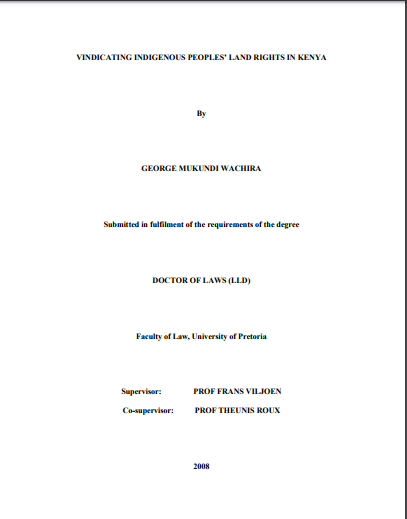Resource information
This thesis examines the extent to which Kenya’s domestic legal framework vindicates indigenous peoples’ land rights. The question of who is an indigenous person in Kenya is, of course, controversial. In order to avoid becoming enmeshed in this debate, this thesis adopts the approach of the African Commission on Human and Peoples’ Rights, which is based on identifying the key concerns faced by marginalised communities who self-identify as indigenous peoples. Such an approach assumes that it really does not matter which label attaches to a group of people when vindicating their fundamental rights, provided that those rights are indeed available to be vindicated. In keeping with this assumption, the main argument of this thesis is that indigenous peoples’ core claim to land rights in Kenya can be accommodated within the mainstream legal framework, including the Constitution, legislation, and judicial decisions. In arguing thus, this thesis contradicts the common assumption, shared by numerous African states, that satisfying indigenous peoples’ claims requires a special legal framework. This assumption is all too often used to deny indigenous peoples’ claims on the basis that satisfying them requires preferential treatment. On the contrary, this thesis argues, it is possible to meet indigenous peoples’ claims by adopting general legal measures aimed at redressing past injustices and continuing socio-economic deprivation and inequality. This thesis further argues that measures aimed at redressing past injustices and alleviating current socio-economic inequality should take into account the particular circumstances of the groups targeted. In the case of indigenous peoples, who rely on their traditional lands for economic sustenance, and for whom land has a special cultural and spiritual significance, this means that the restitution of land should be central to any attempt to redress their particular concerns. As a practical matter, indigenous peoples’ land rights in Kenya may be vindicated in two main ways. The first is through a progressive interpretation of the existing legal framework by courts. Such interpretation hinges on giving effect to existing provisions in Kenya’s Constitution, particularly the right to life, non-discrimination and equality, protection from deprivation of property, and the Trust lands provisions. Progressive interpretation of the existing legal framework could also include recognition and application of the concept of indigenous title. The second way in which indigenous peoples’ land rights may be vindicated is by reforming the law to cater for all previously marginalised groups. Such reforms should include support for land restitution and redistribution, and equal application of African customary law. The first way in which indigenous peoples’ land rights may be vindicated is predicated on judicial activism. Using a court case by the Ogiek indigenous community, this thesis argues that, while the Kenyan legal framework has the potential to protect the land rights of indigenous peoples, its interpretation by the courts has been restrictive. It is therefore imperative that the law should be reformed to accommodate the rights of all marginalised groups. Such reforms need not be specifically designed to protect indigenous peoples, but rather all communities and individuals who are not adequately protected by the existing legal framework. A case study of the Maasai indigenous community is also undertaken to highlight the limitations of assimilationist legal measures that, far from protecting the groups they are meant to assist, instead entrench the status quo. The Maasai group ranches scheme, while ostensibly anchored in the legal framework, was designed to convert otherwise harmonious community land relations to a statutory regime that ignored community traditions and the Maasai’s preferred way of life. The failure of this scheme and the eventual subdivision of Maasai land provide strong evidence of the lack of appreciation and regard for Kenya’s indigenous peoples and the fundamental principles of justice, non-discrimination and equality prevailing at that time. The legal reform option for vindicating indigenous peoples’ rights is dependent upon political processes. By recourse to two comparable experiences, South Africa and Namibia, the thesis demonstrates that indigenous peoples’ land rights can be vindicated through a legal framework adopted to cater for all previously marginalized groups. Albeit fraught with constraints, South Africa’s indigenous peoples have utilised the legal reforms that were enacted to redress the historical injustices of the apartheid regime. Although Namibia has also adopted some legal reforms, especially relating to land redistribution, the apparent lack of political will to address the rights of her most marginalised communities hampers their effectiveness. The Namibian case shows that political processes can not be relied upon to right the wrongs suffered by marginalised peoples, especially when those groups lack political clout. However, as in South Africa, where the end of apartheid provided an ideal political environment to press for reforms that would cater for marginalised peoples’ needs, the political crisis following the December 2007 elections in Kenya provides an important window of opportunity. In the negotiations that followed this crisis, land reform has been identified as one of the key issues that demands comprehensive resolution for peace and prosperity to prevail. It is therefore imperative that genuine reforms that accord all Kenyan people an equitable share of her resources and xii address historical land injustices are adopted. Such reforms, it is argued, would enable indigenous peoples to vindicate their land rights, alongside other marginalised peoples.


